Leadership Strategies for Employee Retention: A BU7039 Report Analysis
VerifiedAdded on 2022/11/13
|18
|4398
|388
Report
AI Summary
This report analyzes leadership approaches and interventions for employee retention, focusing on a workplace challenge within Woolworths. It examines how leadership strategies, including openness, engagement, communication, flexible timing, and learning opportunities, impact employee motivation and commitment. The report evaluates the importance of establishing goals, transparency, innovation, recognition, and real-time feedback. Furthermore, it explores the development of personal development plans with SMART objectives and their application in addressing challenges. The report provides an overview of the leadership approaches and the importance of communication within an organization. This report also highlights the importance of systematic work progress and the infusion of technology. The report concludes with a discussion on the importance of adapting leadership strategies to foster a positive work environment and retain employees. Finally, the report provides several references to support the arguments and findings.
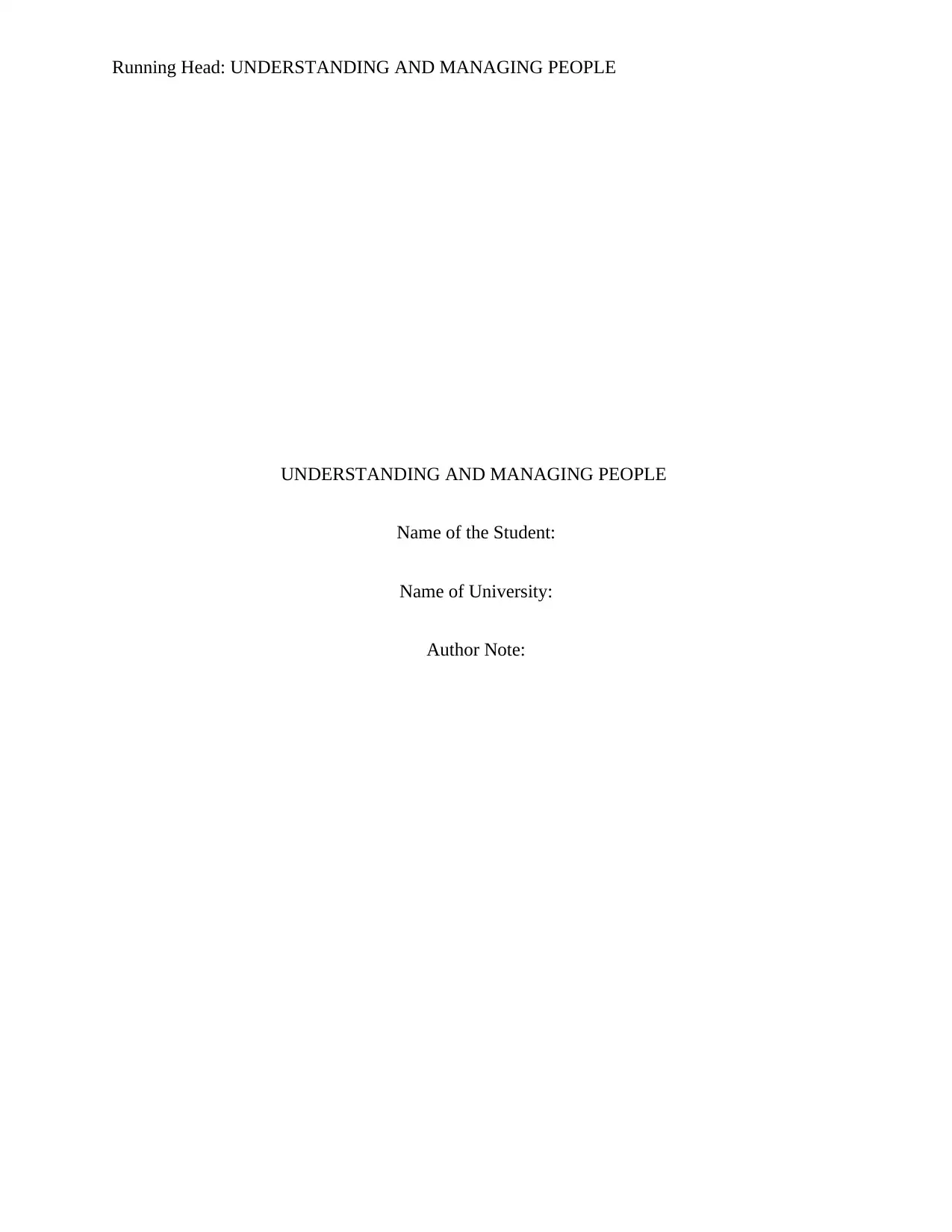
Running Head: UNDERSTANDING AND MANAGING PEOPLE
UNDERSTANDING AND MANAGING PEOPLE
Name of the Student:
Name of University:
Author Note:
UNDERSTANDING AND MANAGING PEOPLE
Name of the Student:
Name of University:
Author Note:
Paraphrase This Document
Need a fresh take? Get an instant paraphrase of this document with our AI Paraphraser
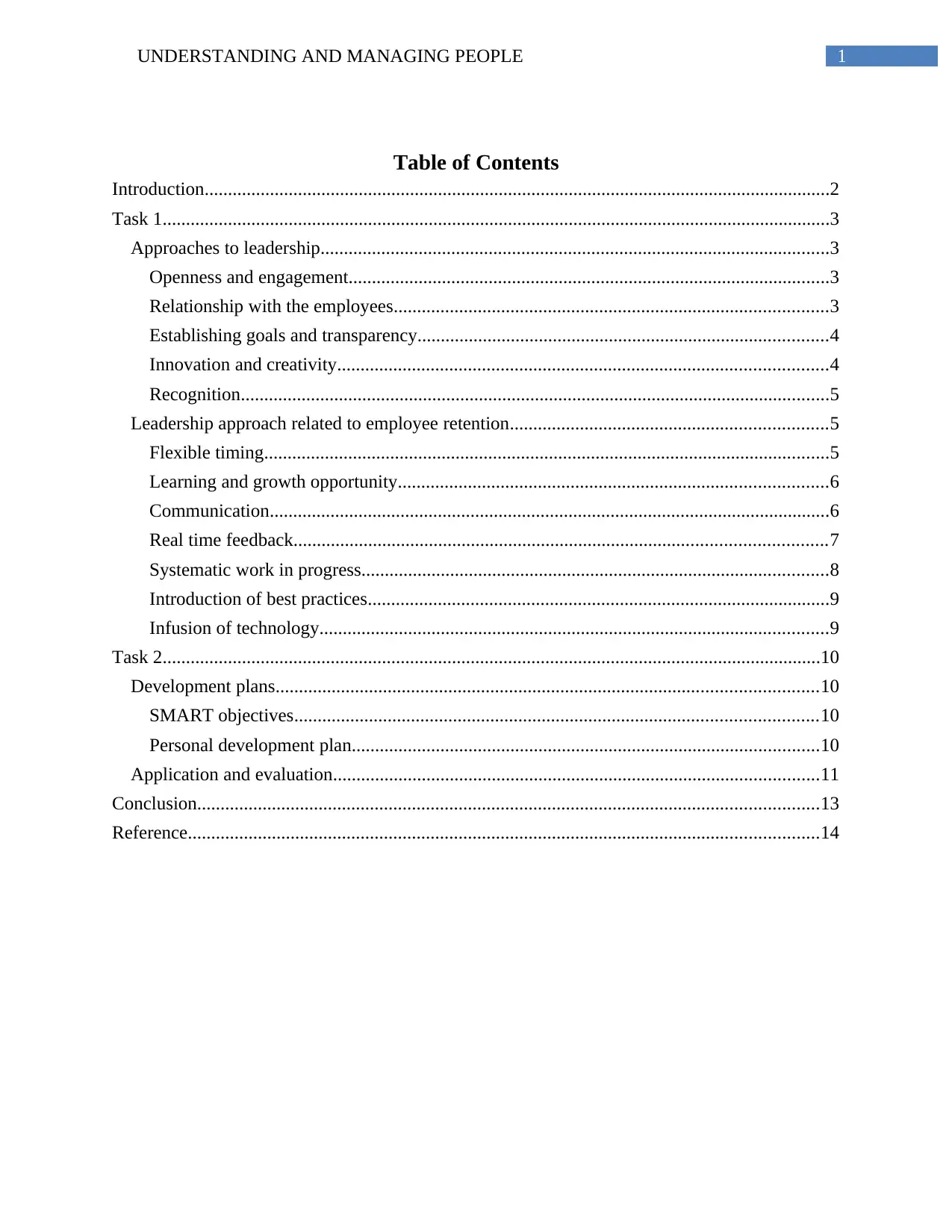
1UNDERSTANDING AND MANAGING PEOPLE
Table of Contents
Introduction......................................................................................................................................2
Task 1...............................................................................................................................................3
Approaches to leadership.............................................................................................................3
Openness and engagement.......................................................................................................3
Relationship with the employees.............................................................................................3
Establishing goals and transparency........................................................................................4
Innovation and creativity.........................................................................................................4
Recognition..............................................................................................................................5
Leadership approach related to employee retention....................................................................5
Flexible timing.........................................................................................................................5
Learning and growth opportunity............................................................................................6
Communication........................................................................................................................6
Real time feedback..................................................................................................................7
Systematic work in progress....................................................................................................8
Introduction of best practices...................................................................................................9
Infusion of technology.............................................................................................................9
Task 2.............................................................................................................................................10
Development plans....................................................................................................................10
SMART objectives................................................................................................................10
Personal development plan....................................................................................................10
Application and evaluation........................................................................................................11
Conclusion.....................................................................................................................................13
Reference.......................................................................................................................................14
Table of Contents
Introduction......................................................................................................................................2
Task 1...............................................................................................................................................3
Approaches to leadership.............................................................................................................3
Openness and engagement.......................................................................................................3
Relationship with the employees.............................................................................................3
Establishing goals and transparency........................................................................................4
Innovation and creativity.........................................................................................................4
Recognition..............................................................................................................................5
Leadership approach related to employee retention....................................................................5
Flexible timing.........................................................................................................................5
Learning and growth opportunity............................................................................................6
Communication........................................................................................................................6
Real time feedback..................................................................................................................7
Systematic work in progress....................................................................................................8
Introduction of best practices...................................................................................................9
Infusion of technology.............................................................................................................9
Task 2.............................................................................................................................................10
Development plans....................................................................................................................10
SMART objectives................................................................................................................10
Personal development plan....................................................................................................10
Application and evaluation........................................................................................................11
Conclusion.....................................................................................................................................13
Reference.......................................................................................................................................14
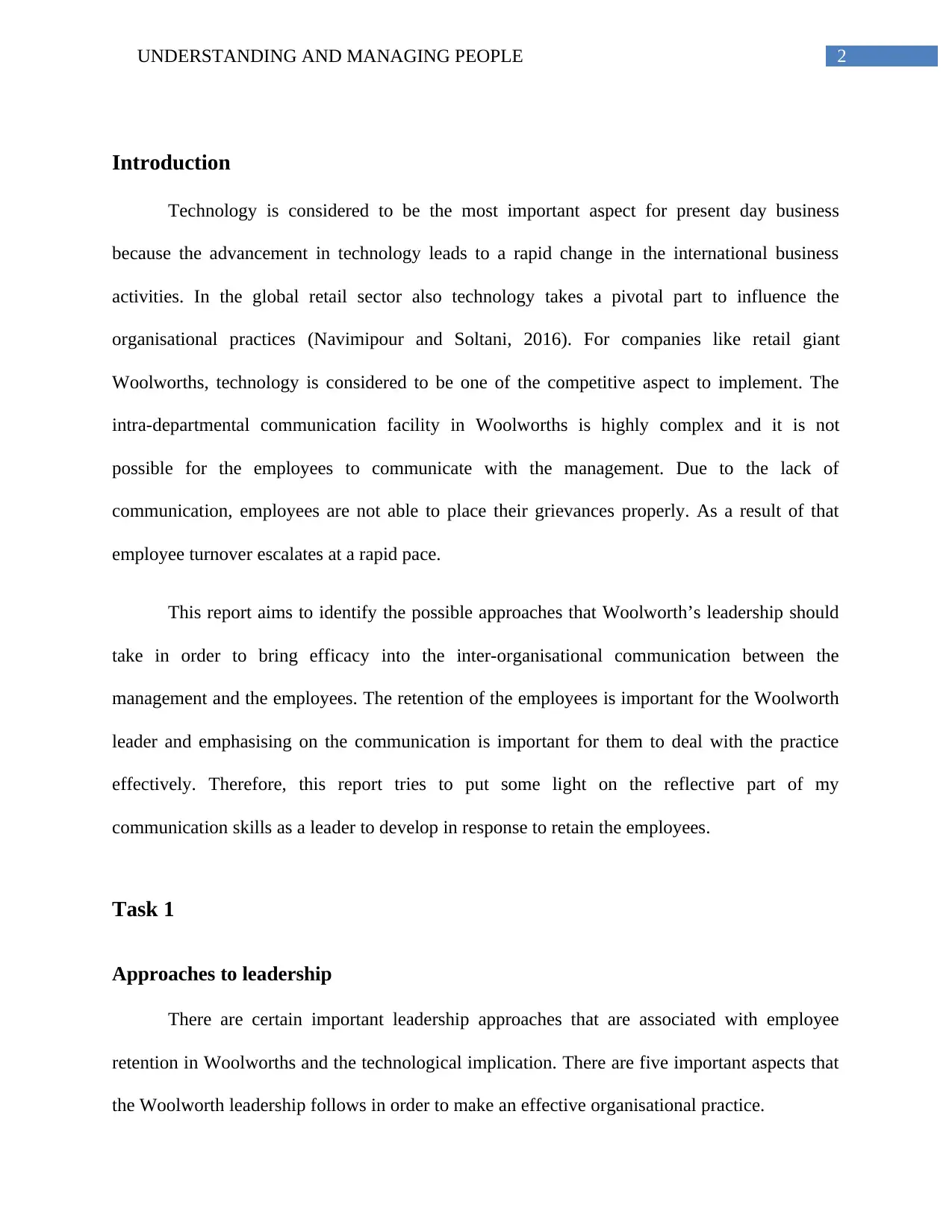
2UNDERSTANDING AND MANAGING PEOPLE
Introduction
Technology is considered to be the most important aspect for present day business
because the advancement in technology leads to a rapid change in the international business
activities. In the global retail sector also technology takes a pivotal part to influence the
organisational practices (Navimipour and Soltani, 2016). For companies like retail giant
Woolworths, technology is considered to be one of the competitive aspect to implement. The
intra-departmental communication facility in Woolworths is highly complex and it is not
possible for the employees to communicate with the management. Due to the lack of
communication, employees are not able to place their grievances properly. As a result of that
employee turnover escalates at a rapid pace.
This report aims to identify the possible approaches that Woolworth’s leadership should
take in order to bring efficacy into the inter-organisational communication between the
management and the employees. The retention of the employees is important for the Woolworth
leader and emphasising on the communication is important for them to deal with the practice
effectively. Therefore, this report tries to put some light on the reflective part of my
communication skills as a leader to develop in response to retain the employees.
Task 1
Approaches to leadership
There are certain important leadership approaches that are associated with employee
retention in Woolworths and the technological implication. There are five important aspects that
the Woolworth leadership follows in order to make an effective organisational practice.
Introduction
Technology is considered to be the most important aspect for present day business
because the advancement in technology leads to a rapid change in the international business
activities. In the global retail sector also technology takes a pivotal part to influence the
organisational practices (Navimipour and Soltani, 2016). For companies like retail giant
Woolworths, technology is considered to be one of the competitive aspect to implement. The
intra-departmental communication facility in Woolworths is highly complex and it is not
possible for the employees to communicate with the management. Due to the lack of
communication, employees are not able to place their grievances properly. As a result of that
employee turnover escalates at a rapid pace.
This report aims to identify the possible approaches that Woolworth’s leadership should
take in order to bring efficacy into the inter-organisational communication between the
management and the employees. The retention of the employees is important for the Woolworth
leader and emphasising on the communication is important for them to deal with the practice
effectively. Therefore, this report tries to put some light on the reflective part of my
communication skills as a leader to develop in response to retain the employees.
Task 1
Approaches to leadership
There are certain important leadership approaches that are associated with employee
retention in Woolworths and the technological implication. There are five important aspects that
the Woolworth leadership follows in order to make an effective organisational practice.
⊘ This is a preview!⊘
Do you want full access?
Subscribe today to unlock all pages.

Trusted by 1+ million students worldwide
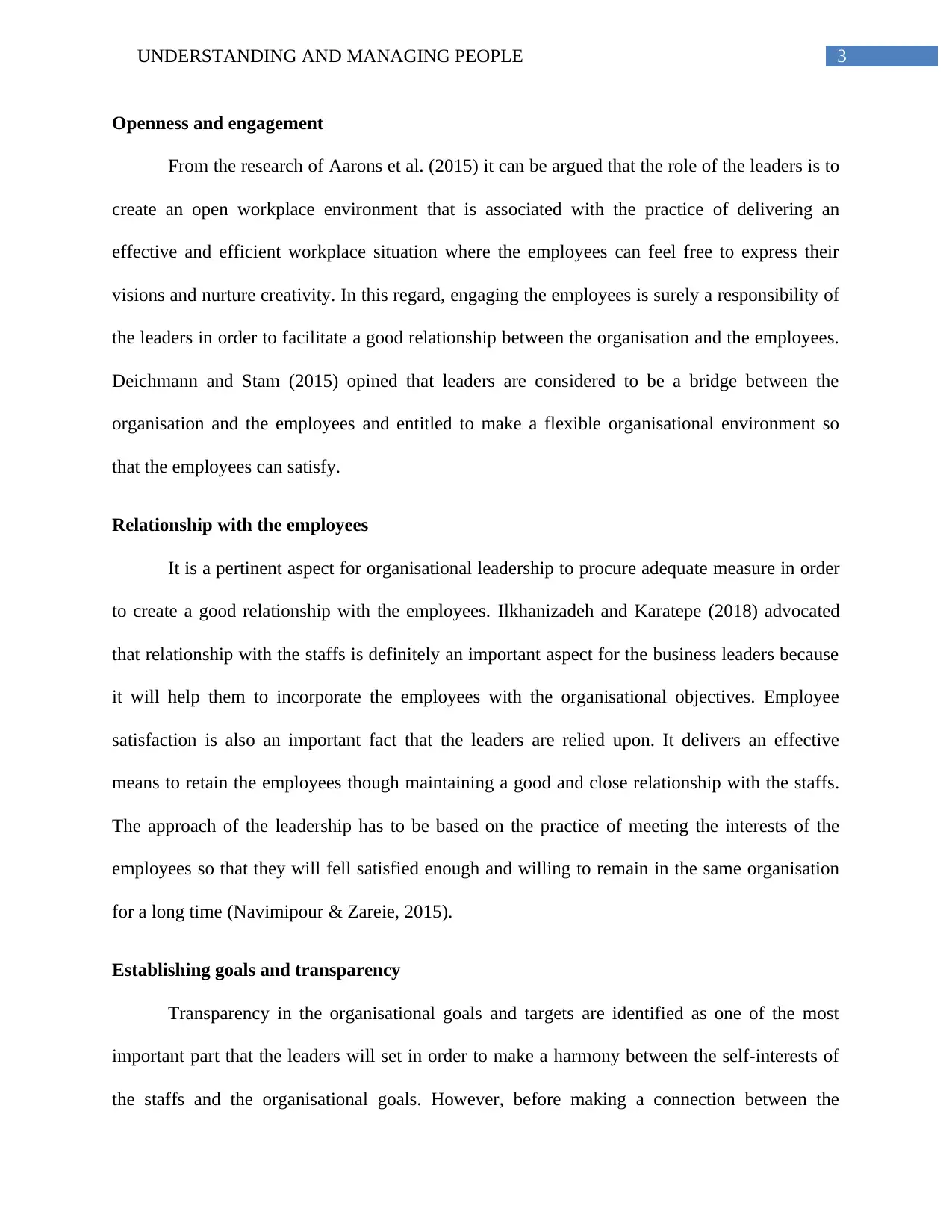
3UNDERSTANDING AND MANAGING PEOPLE
Openness and engagement
From the research of Aarons et al. (2015) it can be argued that the role of the leaders is to
create an open workplace environment that is associated with the practice of delivering an
effective and efficient workplace situation where the employees can feel free to express their
visions and nurture creativity. In this regard, engaging the employees is surely a responsibility of
the leaders in order to facilitate a good relationship between the organisation and the employees.
Deichmann and Stam (2015) opined that leaders are considered to be a bridge between the
organisation and the employees and entitled to make a flexible organisational environment so
that the employees can satisfy.
Relationship with the employees
It is a pertinent aspect for organisational leadership to procure adequate measure in order
to create a good relationship with the employees. Ilkhanizadeh and Karatepe (2018) advocated
that relationship with the staffs is definitely an important aspect for the business leaders because
it will help them to incorporate the employees with the organisational objectives. Employee
satisfaction is also an important fact that the leaders are relied upon. It delivers an effective
means to retain the employees though maintaining a good and close relationship with the staffs.
The approach of the leadership has to be based on the practice of meeting the interests of the
employees so that they will fell satisfied enough and willing to remain in the same organisation
for a long time (Navimipour & Zareie, 2015).
Establishing goals and transparency
Transparency in the organisational goals and targets are identified as one of the most
important part that the leaders will set in order to make a harmony between the self-interests of
the staffs and the organisational goals. However, before making a connection between the
Openness and engagement
From the research of Aarons et al. (2015) it can be argued that the role of the leaders is to
create an open workplace environment that is associated with the practice of delivering an
effective and efficient workplace situation where the employees can feel free to express their
visions and nurture creativity. In this regard, engaging the employees is surely a responsibility of
the leaders in order to facilitate a good relationship between the organisation and the employees.
Deichmann and Stam (2015) opined that leaders are considered to be a bridge between the
organisation and the employees and entitled to make a flexible organisational environment so
that the employees can satisfy.
Relationship with the employees
It is a pertinent aspect for organisational leadership to procure adequate measure in order
to create a good relationship with the employees. Ilkhanizadeh and Karatepe (2018) advocated
that relationship with the staffs is definitely an important aspect for the business leaders because
it will help them to incorporate the employees with the organisational objectives. Employee
satisfaction is also an important fact that the leaders are relied upon. It delivers an effective
means to retain the employees though maintaining a good and close relationship with the staffs.
The approach of the leadership has to be based on the practice of meeting the interests of the
employees so that they will fell satisfied enough and willing to remain in the same organisation
for a long time (Navimipour & Zareie, 2015).
Establishing goals and transparency
Transparency in the organisational goals and targets are identified as one of the most
important part that the leaders will set in order to make a harmony between the self-interests of
the staffs and the organisational goals. However, before making a connection between the
Paraphrase This Document
Need a fresh take? Get an instant paraphrase of this document with our AI Paraphraser
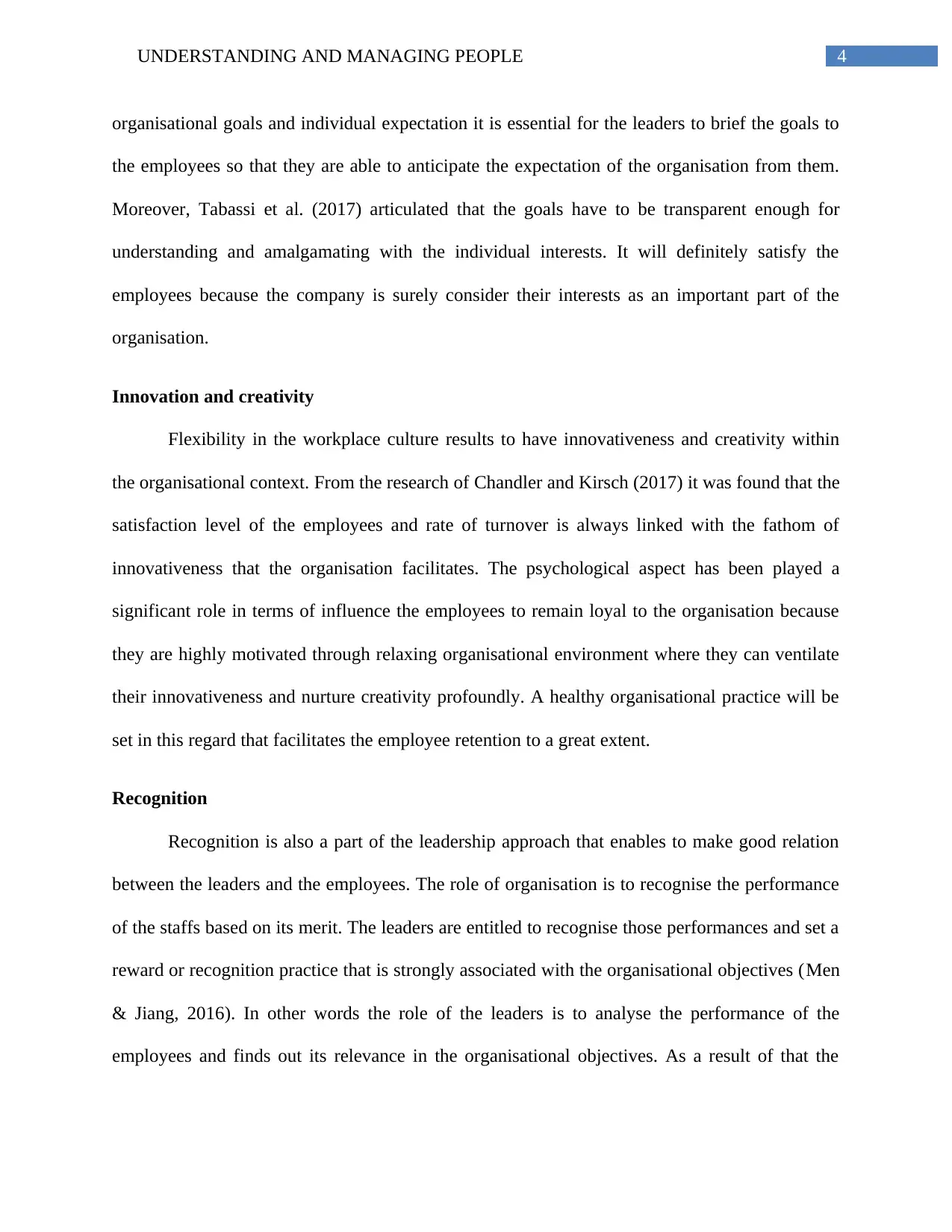
4UNDERSTANDING AND MANAGING PEOPLE
organisational goals and individual expectation it is essential for the leaders to brief the goals to
the employees so that they are able to anticipate the expectation of the organisation from them.
Moreover, Tabassi et al. (2017) articulated that the goals have to be transparent enough for
understanding and amalgamating with the individual interests. It will definitely satisfy the
employees because the company is surely consider their interests as an important part of the
organisation.
Innovation and creativity
Flexibility in the workplace culture results to have innovativeness and creativity within
the organisational context. From the research of Chandler and Kirsch (2017) it was found that the
satisfaction level of the employees and rate of turnover is always linked with the fathom of
innovativeness that the organisation facilitates. The psychological aspect has been played a
significant role in terms of influence the employees to remain loyal to the organisation because
they are highly motivated through relaxing organisational environment where they can ventilate
their innovativeness and nurture creativity profoundly. A healthy organisational practice will be
set in this regard that facilitates the employee retention to a great extent.
Recognition
Recognition is also a part of the leadership approach that enables to make good relation
between the leaders and the employees. The role of organisation is to recognise the performance
of the staffs based on its merit. The leaders are entitled to recognise those performances and set a
reward or recognition practice that is strongly associated with the organisational objectives (Men
& Jiang, 2016). In other words the role of the leaders is to analyse the performance of the
employees and finds out its relevance in the organisational objectives. As a result of that the
organisational goals and individual expectation it is essential for the leaders to brief the goals to
the employees so that they are able to anticipate the expectation of the organisation from them.
Moreover, Tabassi et al. (2017) articulated that the goals have to be transparent enough for
understanding and amalgamating with the individual interests. It will definitely satisfy the
employees because the company is surely consider their interests as an important part of the
organisation.
Innovation and creativity
Flexibility in the workplace culture results to have innovativeness and creativity within
the organisational context. From the research of Chandler and Kirsch (2017) it was found that the
satisfaction level of the employees and rate of turnover is always linked with the fathom of
innovativeness that the organisation facilitates. The psychological aspect has been played a
significant role in terms of influence the employees to remain loyal to the organisation because
they are highly motivated through relaxing organisational environment where they can ventilate
their innovativeness and nurture creativity profoundly. A healthy organisational practice will be
set in this regard that facilitates the employee retention to a great extent.
Recognition
Recognition is also a part of the leadership approach that enables to make good relation
between the leaders and the employees. The role of organisation is to recognise the performance
of the staffs based on its merit. The leaders are entitled to recognise those performances and set a
reward or recognition practice that is strongly associated with the organisational objectives (Men
& Jiang, 2016). In other words the role of the leaders is to analyse the performance of the
employees and finds out its relevance in the organisational objectives. As a result of that the
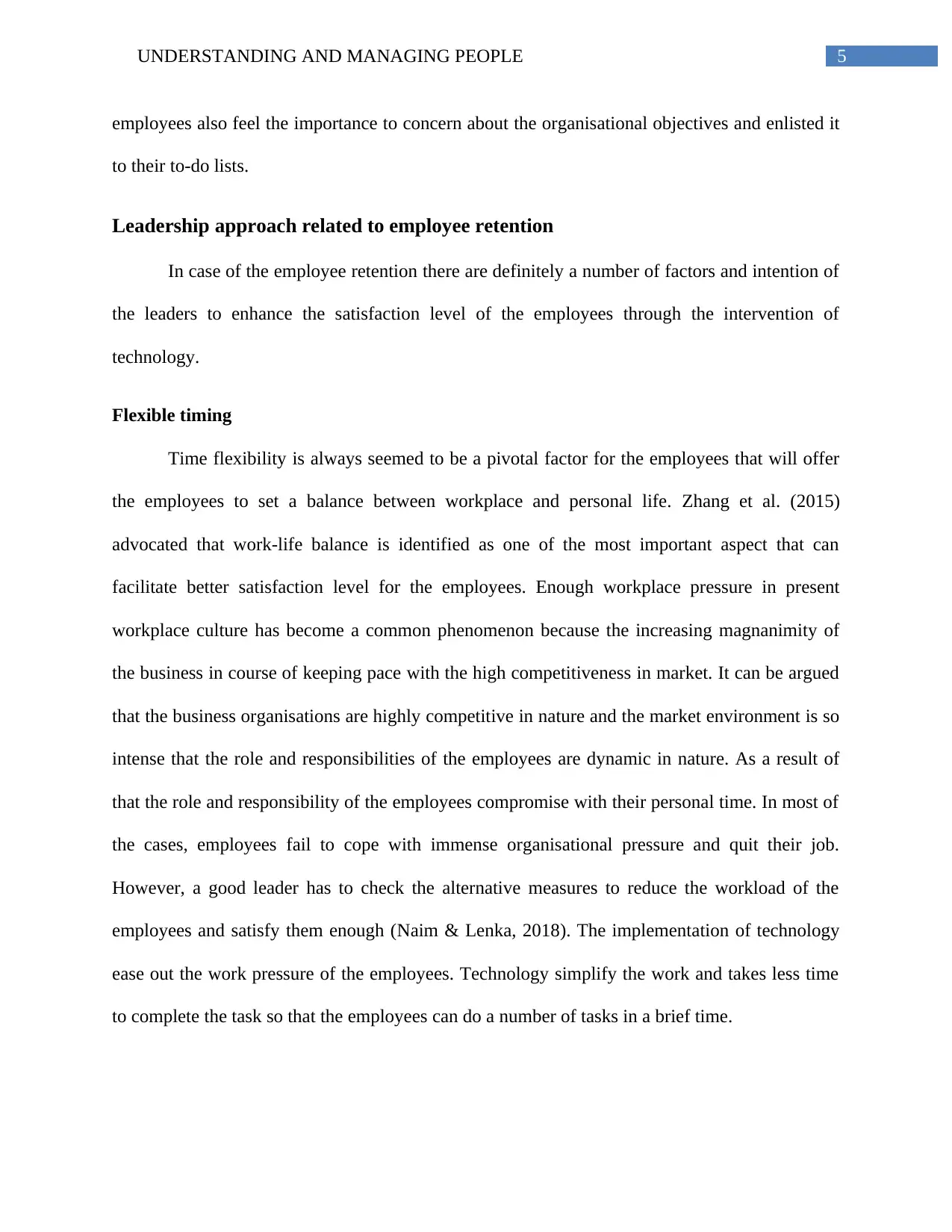
5UNDERSTANDING AND MANAGING PEOPLE
employees also feel the importance to concern about the organisational objectives and enlisted it
to their to-do lists.
Leadership approach related to employee retention
In case of the employee retention there are definitely a number of factors and intention of
the leaders to enhance the satisfaction level of the employees through the intervention of
technology.
Flexible timing
Time flexibility is always seemed to be a pivotal factor for the employees that will offer
the employees to set a balance between workplace and personal life. Zhang et al. (2015)
advocated that work-life balance is identified as one of the most important aspect that can
facilitate better satisfaction level for the employees. Enough workplace pressure in present
workplace culture has become a common phenomenon because the increasing magnanimity of
the business in course of keeping pace with the high competitiveness in market. It can be argued
that the business organisations are highly competitive in nature and the market environment is so
intense that the role and responsibilities of the employees are dynamic in nature. As a result of
that the role and responsibility of the employees compromise with their personal time. In most of
the cases, employees fail to cope with immense organisational pressure and quit their job.
However, a good leader has to check the alternative measures to reduce the workload of the
employees and satisfy them enough (Naim & Lenka, 2018). The implementation of technology
ease out the work pressure of the employees. Technology simplify the work and takes less time
to complete the task so that the employees can do a number of tasks in a brief time.
employees also feel the importance to concern about the organisational objectives and enlisted it
to their to-do lists.
Leadership approach related to employee retention
In case of the employee retention there are definitely a number of factors and intention of
the leaders to enhance the satisfaction level of the employees through the intervention of
technology.
Flexible timing
Time flexibility is always seemed to be a pivotal factor for the employees that will offer
the employees to set a balance between workplace and personal life. Zhang et al. (2015)
advocated that work-life balance is identified as one of the most important aspect that can
facilitate better satisfaction level for the employees. Enough workplace pressure in present
workplace culture has become a common phenomenon because the increasing magnanimity of
the business in course of keeping pace with the high competitiveness in market. It can be argued
that the business organisations are highly competitive in nature and the market environment is so
intense that the role and responsibilities of the employees are dynamic in nature. As a result of
that the role and responsibility of the employees compromise with their personal time. In most of
the cases, employees fail to cope with immense organisational pressure and quit their job.
However, a good leader has to check the alternative measures to reduce the workload of the
employees and satisfy them enough (Naim & Lenka, 2018). The implementation of technology
ease out the work pressure of the employees. Technology simplify the work and takes less time
to complete the task so that the employees can do a number of tasks in a brief time.
⊘ This is a preview!⊘
Do you want full access?
Subscribe today to unlock all pages.

Trusted by 1+ million students worldwide
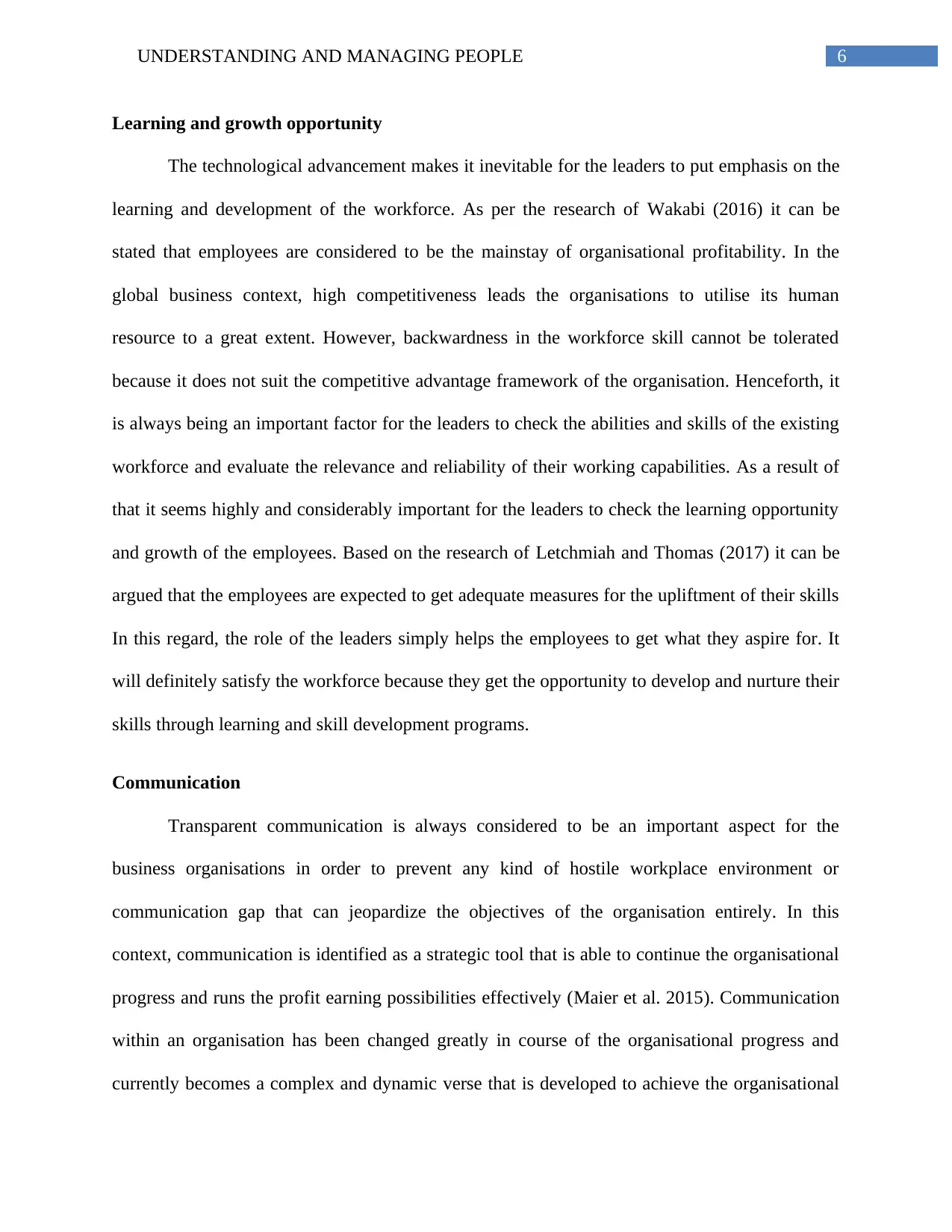
6UNDERSTANDING AND MANAGING PEOPLE
Learning and growth opportunity
The technological advancement makes it inevitable for the leaders to put emphasis on the
learning and development of the workforce. As per the research of Wakabi (2016) it can be
stated that employees are considered to be the mainstay of organisational profitability. In the
global business context, high competitiveness leads the organisations to utilise its human
resource to a great extent. However, backwardness in the workforce skill cannot be tolerated
because it does not suit the competitive advantage framework of the organisation. Henceforth, it
is always being an important factor for the leaders to check the abilities and skills of the existing
workforce and evaluate the relevance and reliability of their working capabilities. As a result of
that it seems highly and considerably important for the leaders to check the learning opportunity
and growth of the employees. Based on the research of Letchmiah and Thomas (2017) it can be
argued that the employees are expected to get adequate measures for the upliftment of their skills
In this regard, the role of the leaders simply helps the employees to get what they aspire for. It
will definitely satisfy the workforce because they get the opportunity to develop and nurture their
skills through learning and skill development programs.
Communication
Transparent communication is always considered to be an important aspect for the
business organisations in order to prevent any kind of hostile workplace environment or
communication gap that can jeopardize the objectives of the organisation entirely. In this
context, communication is identified as a strategic tool that is able to continue the organisational
progress and runs the profit earning possibilities effectively (Maier et al. 2015). Communication
within an organisation has been changed greatly in course of the organisational progress and
currently becomes a complex and dynamic verse that is developed to achieve the organisational
Learning and growth opportunity
The technological advancement makes it inevitable for the leaders to put emphasis on the
learning and development of the workforce. As per the research of Wakabi (2016) it can be
stated that employees are considered to be the mainstay of organisational profitability. In the
global business context, high competitiveness leads the organisations to utilise its human
resource to a great extent. However, backwardness in the workforce skill cannot be tolerated
because it does not suit the competitive advantage framework of the organisation. Henceforth, it
is always being an important factor for the leaders to check the abilities and skills of the existing
workforce and evaluate the relevance and reliability of their working capabilities. As a result of
that it seems highly and considerably important for the leaders to check the learning opportunity
and growth of the employees. Based on the research of Letchmiah and Thomas (2017) it can be
argued that the employees are expected to get adequate measures for the upliftment of their skills
In this regard, the role of the leaders simply helps the employees to get what they aspire for. It
will definitely satisfy the workforce because they get the opportunity to develop and nurture their
skills through learning and skill development programs.
Communication
Transparent communication is always considered to be an important aspect for the
business organisations in order to prevent any kind of hostile workplace environment or
communication gap that can jeopardize the objectives of the organisation entirely. In this
context, communication is identified as a strategic tool that is able to continue the organisational
progress and runs the profit earning possibilities effectively (Maier et al. 2015). Communication
within an organisation has been changed greatly in course of the organisational progress and
currently becomes a complex and dynamic verse that is developed to achieve the organisational
Paraphrase This Document
Need a fresh take? Get an instant paraphrase of this document with our AI Paraphraser
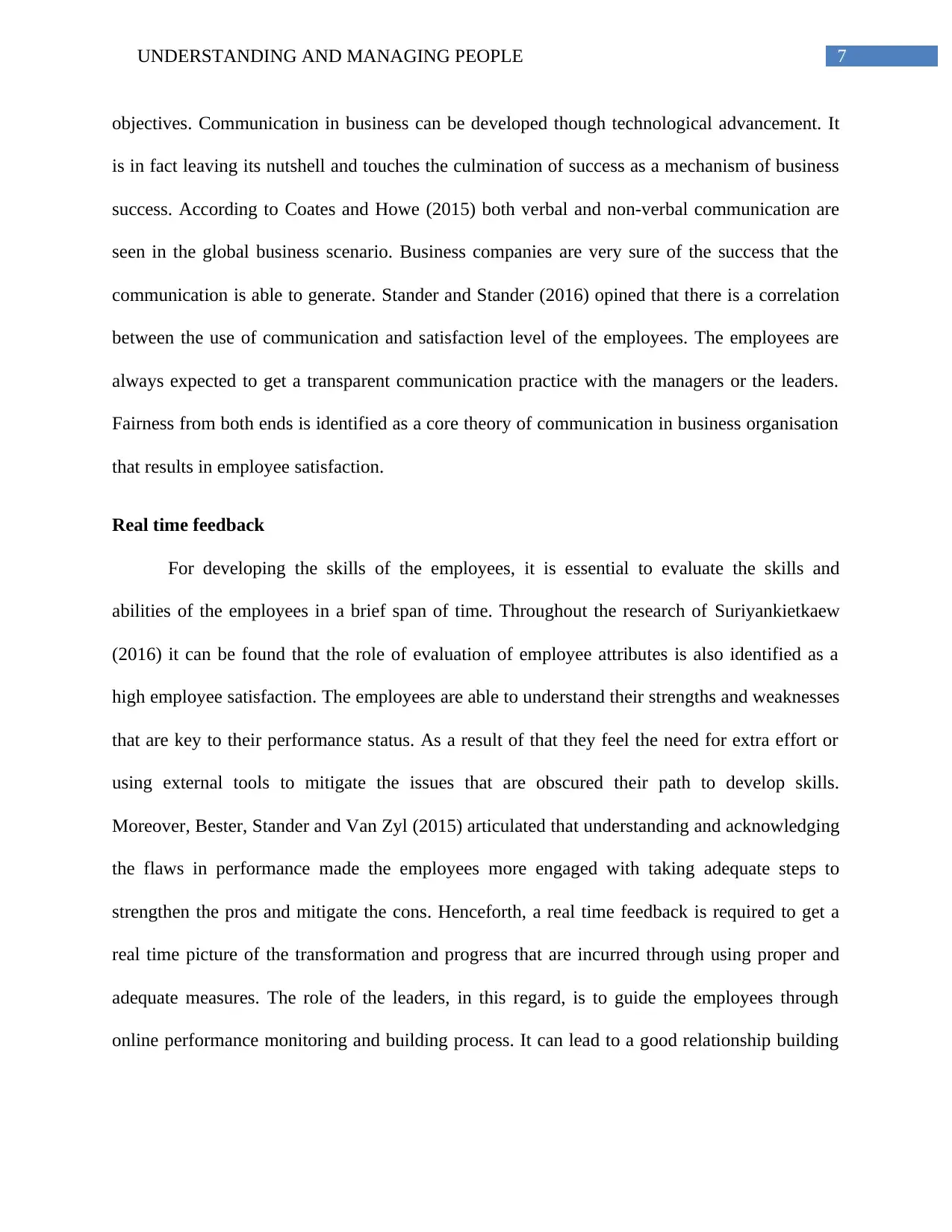
7UNDERSTANDING AND MANAGING PEOPLE
objectives. Communication in business can be developed though technological advancement. It
is in fact leaving its nutshell and touches the culmination of success as a mechanism of business
success. According to Coates and Howe (2015) both verbal and non-verbal communication are
seen in the global business scenario. Business companies are very sure of the success that the
communication is able to generate. Stander and Stander (2016) opined that there is a correlation
between the use of communication and satisfaction level of the employees. The employees are
always expected to get a transparent communication practice with the managers or the leaders.
Fairness from both ends is identified as a core theory of communication in business organisation
that results in employee satisfaction.
Real time feedback
For developing the skills of the employees, it is essential to evaluate the skills and
abilities of the employees in a brief span of time. Throughout the research of Suriyankietkaew
(2016) it can be found that the role of evaluation of employee attributes is also identified as a
high employee satisfaction. The employees are able to understand their strengths and weaknesses
that are key to their performance status. As a result of that they feel the need for extra effort or
using external tools to mitigate the issues that are obscured their path to develop skills.
Moreover, Bester, Stander and Van Zyl (2015) articulated that understanding and acknowledging
the flaws in performance made the employees more engaged with taking adequate steps to
strengthen the pros and mitigate the cons. Henceforth, a real time feedback is required to get a
real time picture of the transformation and progress that are incurred through using proper and
adequate measures. The role of the leaders, in this regard, is to guide the employees through
online performance monitoring and building process. It can lead to a good relationship building
objectives. Communication in business can be developed though technological advancement. It
is in fact leaving its nutshell and touches the culmination of success as a mechanism of business
success. According to Coates and Howe (2015) both verbal and non-verbal communication are
seen in the global business scenario. Business companies are very sure of the success that the
communication is able to generate. Stander and Stander (2016) opined that there is a correlation
between the use of communication and satisfaction level of the employees. The employees are
always expected to get a transparent communication practice with the managers or the leaders.
Fairness from both ends is identified as a core theory of communication in business organisation
that results in employee satisfaction.
Real time feedback
For developing the skills of the employees, it is essential to evaluate the skills and
abilities of the employees in a brief span of time. Throughout the research of Suriyankietkaew
(2016) it can be found that the role of evaluation of employee attributes is also identified as a
high employee satisfaction. The employees are able to understand their strengths and weaknesses
that are key to their performance status. As a result of that they feel the need for extra effort or
using external tools to mitigate the issues that are obscured their path to develop skills.
Moreover, Bester, Stander and Van Zyl (2015) articulated that understanding and acknowledging
the flaws in performance made the employees more engaged with taking adequate steps to
strengthen the pros and mitigate the cons. Henceforth, a real time feedback is required to get a
real time picture of the transformation and progress that are incurred through using proper and
adequate measures. The role of the leaders, in this regard, is to guide the employees through
online performance monitoring and building process. It can lead to a good relationship building
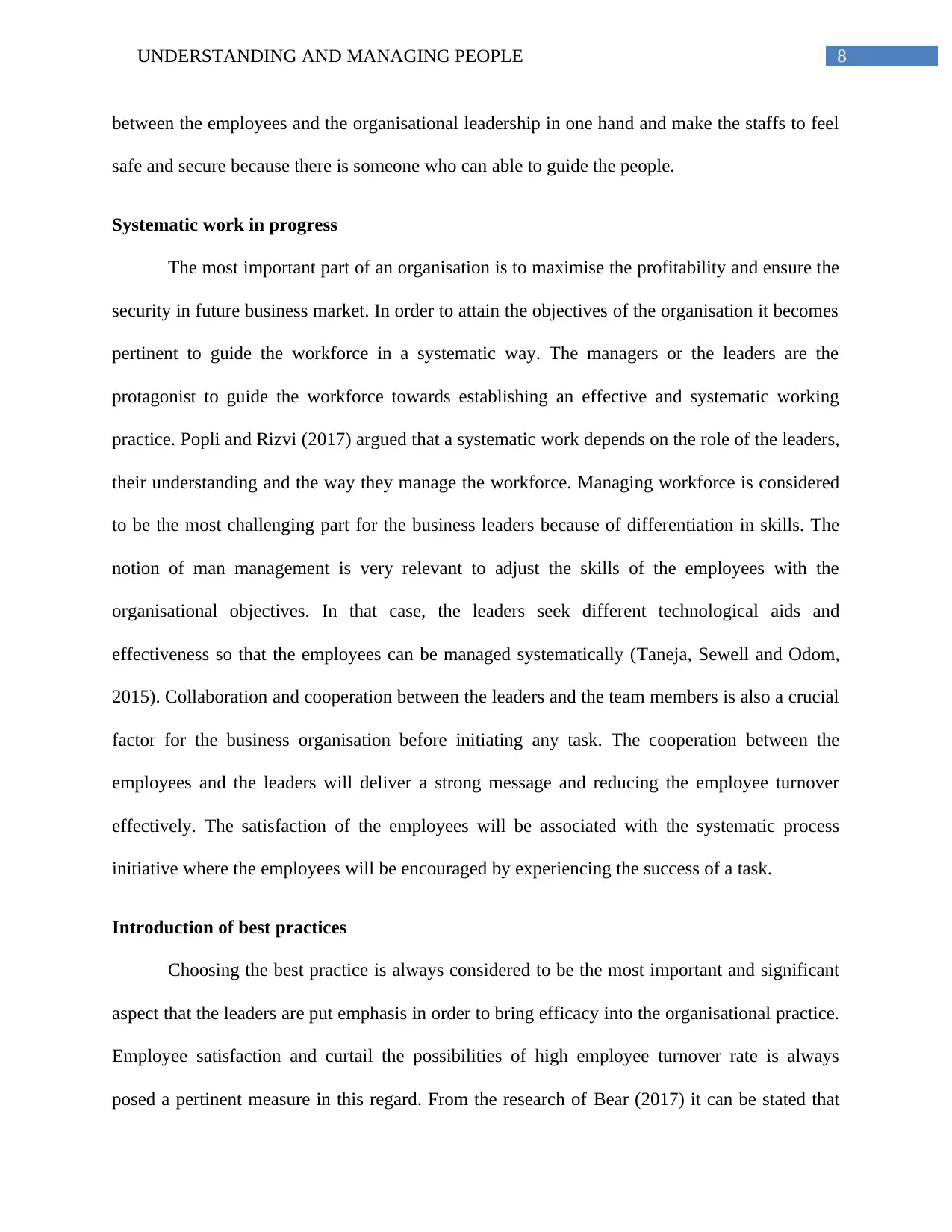
8UNDERSTANDING AND MANAGING PEOPLE
between the employees and the organisational leadership in one hand and make the staffs to feel
safe and secure because there is someone who can able to guide the people.
Systematic work in progress
The most important part of an organisation is to maximise the profitability and ensure the
security in future business market. In order to attain the objectives of the organisation it becomes
pertinent to guide the workforce in a systematic way. The managers or the leaders are the
protagonist to guide the workforce towards establishing an effective and systematic working
practice. Popli and Rizvi (2017) argued that a systematic work depends on the role of the leaders,
their understanding and the way they manage the workforce. Managing workforce is considered
to be the most challenging part for the business leaders because of differentiation in skills. The
notion of man management is very relevant to adjust the skills of the employees with the
organisational objectives. In that case, the leaders seek different technological aids and
effectiveness so that the employees can be managed systematically (Taneja, Sewell and Odom,
2015). Collaboration and cooperation between the leaders and the team members is also a crucial
factor for the business organisation before initiating any task. The cooperation between the
employees and the leaders will deliver a strong message and reducing the employee turnover
effectively. The satisfaction of the employees will be associated with the systematic process
initiative where the employees will be encouraged by experiencing the success of a task.
Introduction of best practices
Choosing the best practice is always considered to be the most important and significant
aspect that the leaders are put emphasis in order to bring efficacy into the organisational practice.
Employee satisfaction and curtail the possibilities of high employee turnover rate is always
posed a pertinent measure in this regard. From the research of Bear (2017) it can be stated that
between the employees and the organisational leadership in one hand and make the staffs to feel
safe and secure because there is someone who can able to guide the people.
Systematic work in progress
The most important part of an organisation is to maximise the profitability and ensure the
security in future business market. In order to attain the objectives of the organisation it becomes
pertinent to guide the workforce in a systematic way. The managers or the leaders are the
protagonist to guide the workforce towards establishing an effective and systematic working
practice. Popli and Rizvi (2017) argued that a systematic work depends on the role of the leaders,
their understanding and the way they manage the workforce. Managing workforce is considered
to be the most challenging part for the business leaders because of differentiation in skills. The
notion of man management is very relevant to adjust the skills of the employees with the
organisational objectives. In that case, the leaders seek different technological aids and
effectiveness so that the employees can be managed systematically (Taneja, Sewell and Odom,
2015). Collaboration and cooperation between the leaders and the team members is also a crucial
factor for the business organisation before initiating any task. The cooperation between the
employees and the leaders will deliver a strong message and reducing the employee turnover
effectively. The satisfaction of the employees will be associated with the systematic process
initiative where the employees will be encouraged by experiencing the success of a task.
Introduction of best practices
Choosing the best practice is always considered to be the most important and significant
aspect that the leaders are put emphasis in order to bring efficacy into the organisational practice.
Employee satisfaction and curtail the possibilities of high employee turnover rate is always
posed a pertinent measure in this regard. From the research of Bear (2017) it can be stated that
⊘ This is a preview!⊘
Do you want full access?
Subscribe today to unlock all pages.

Trusted by 1+ million students worldwide
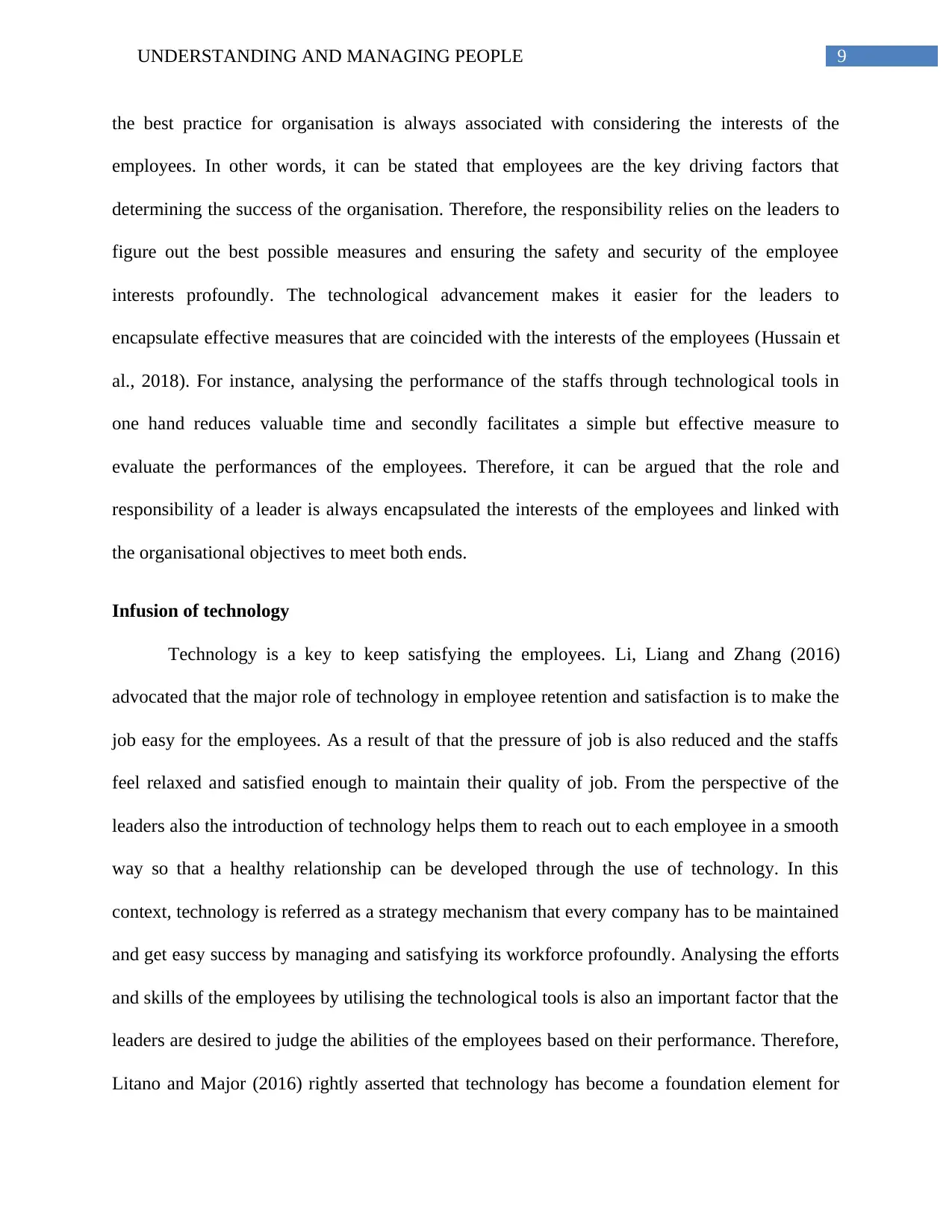
9UNDERSTANDING AND MANAGING PEOPLE
the best practice for organisation is always associated with considering the interests of the
employees. In other words, it can be stated that employees are the key driving factors that
determining the success of the organisation. Therefore, the responsibility relies on the leaders to
figure out the best possible measures and ensuring the safety and security of the employee
interests profoundly. The technological advancement makes it easier for the leaders to
encapsulate effective measures that are coincided with the interests of the employees (Hussain et
al., 2018). For instance, analysing the performance of the staffs through technological tools in
one hand reduces valuable time and secondly facilitates a simple but effective measure to
evaluate the performances of the employees. Therefore, it can be argued that the role and
responsibility of a leader is always encapsulated the interests of the employees and linked with
the organisational objectives to meet both ends.
Infusion of technology
Technology is a key to keep satisfying the employees. Li, Liang and Zhang (2016)
advocated that the major role of technology in employee retention and satisfaction is to make the
job easy for the employees. As a result of that the pressure of job is also reduced and the staffs
feel relaxed and satisfied enough to maintain their quality of job. From the perspective of the
leaders also the introduction of technology helps them to reach out to each employee in a smooth
way so that a healthy relationship can be developed through the use of technology. In this
context, technology is referred as a strategy mechanism that every company has to be maintained
and get easy success by managing and satisfying its workforce profoundly. Analysing the efforts
and skills of the employees by utilising the technological tools is also an important factor that the
leaders are desired to judge the abilities of the employees based on their performance. Therefore,
Litano and Major (2016) rightly asserted that technology has become a foundation element for
the best practice for organisation is always associated with considering the interests of the
employees. In other words, it can be stated that employees are the key driving factors that
determining the success of the organisation. Therefore, the responsibility relies on the leaders to
figure out the best possible measures and ensuring the safety and security of the employee
interests profoundly. The technological advancement makes it easier for the leaders to
encapsulate effective measures that are coincided with the interests of the employees (Hussain et
al., 2018). For instance, analysing the performance of the staffs through technological tools in
one hand reduces valuable time and secondly facilitates a simple but effective measure to
evaluate the performances of the employees. Therefore, it can be argued that the role and
responsibility of a leader is always encapsulated the interests of the employees and linked with
the organisational objectives to meet both ends.
Infusion of technology
Technology is a key to keep satisfying the employees. Li, Liang and Zhang (2016)
advocated that the major role of technology in employee retention and satisfaction is to make the
job easy for the employees. As a result of that the pressure of job is also reduced and the staffs
feel relaxed and satisfied enough to maintain their quality of job. From the perspective of the
leaders also the introduction of technology helps them to reach out to each employee in a smooth
way so that a healthy relationship can be developed through the use of technology. In this
context, technology is referred as a strategy mechanism that every company has to be maintained
and get easy success by managing and satisfying its workforce profoundly. Analysing the efforts
and skills of the employees by utilising the technological tools is also an important factor that the
leaders are desired to judge the abilities of the employees based on their performance. Therefore,
Litano and Major (2016) rightly asserted that technology has become a foundation element for
Paraphrase This Document
Need a fresh take? Get an instant paraphrase of this document with our AI Paraphraser
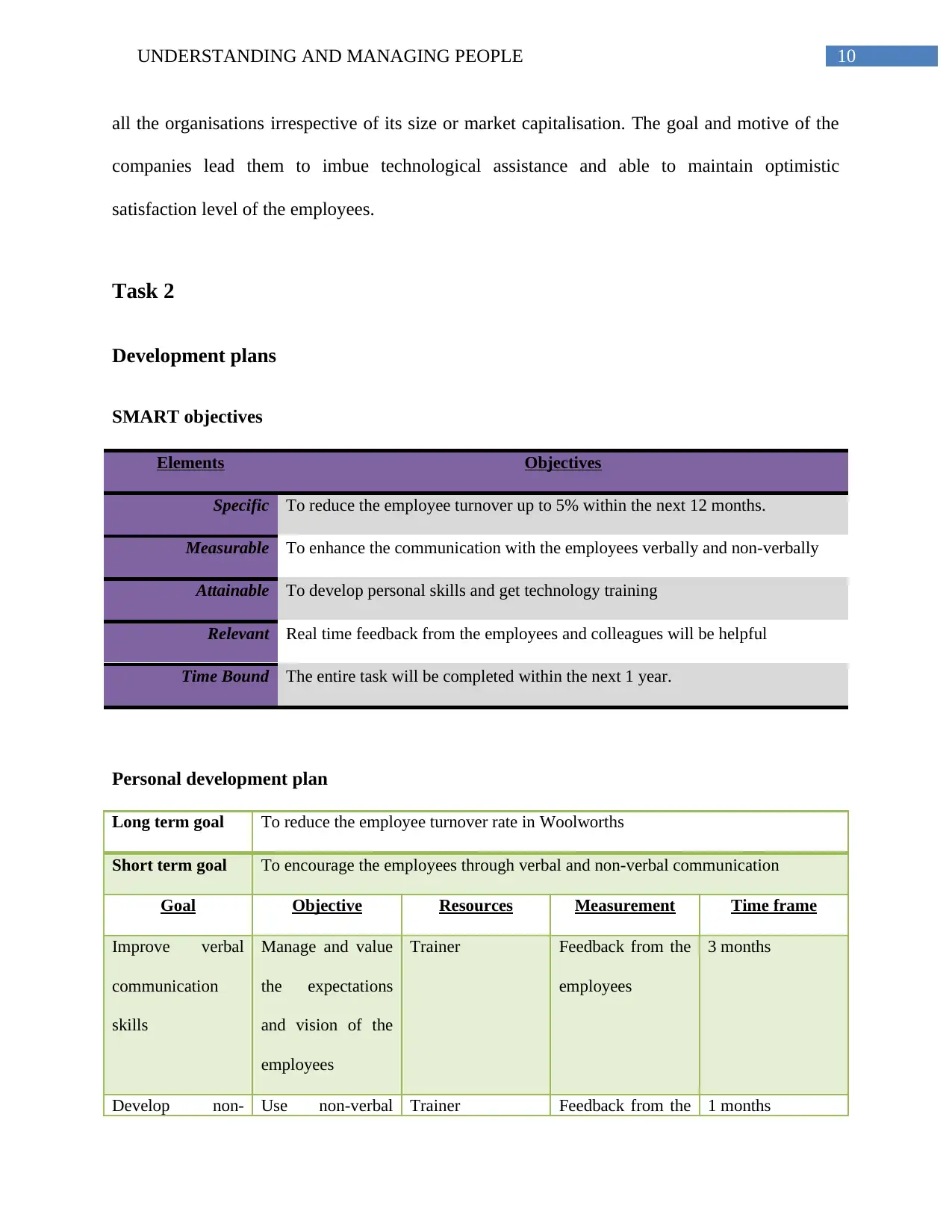
10UNDERSTANDING AND MANAGING PEOPLE
all the organisations irrespective of its size or market capitalisation. The goal and motive of the
companies lead them to imbue technological assistance and able to maintain optimistic
satisfaction level of the employees.
Task 2
Development plans
SMART objectives
Elements Objectives
Specific To reduce the employee turnover up to 5% within the next 12 months.
Measurable To enhance the communication with the employees verbally and non-verbally
Attainable To develop personal skills and get technology training
Relevant Real time feedback from the employees and colleagues will be helpful
Time Bound The entire task will be completed within the next 1 year.
Personal development plan
Long term goal To reduce the employee turnover rate in Woolworths
Short term goal To encourage the employees through verbal and non-verbal communication
Goal Objective Resources Measurement Time frame
Improve verbal
communication
skills
Manage and value
the expectations
and vision of the
employees
Trainer Feedback from the
employees
3 months
Develop non- Use non-verbal Trainer Feedback from the 1 months
all the organisations irrespective of its size or market capitalisation. The goal and motive of the
companies lead them to imbue technological assistance and able to maintain optimistic
satisfaction level of the employees.
Task 2
Development plans
SMART objectives
Elements Objectives
Specific To reduce the employee turnover up to 5% within the next 12 months.
Measurable To enhance the communication with the employees verbally and non-verbally
Attainable To develop personal skills and get technology training
Relevant Real time feedback from the employees and colleagues will be helpful
Time Bound The entire task will be completed within the next 1 year.
Personal development plan
Long term goal To reduce the employee turnover rate in Woolworths
Short term goal To encourage the employees through verbal and non-verbal communication
Goal Objective Resources Measurement Time frame
Improve verbal
communication
skills
Manage and value
the expectations
and vision of the
employees
Trainer Feedback from the
employees
3 months
Develop non- Use non-verbal Trainer Feedback from the 1 months
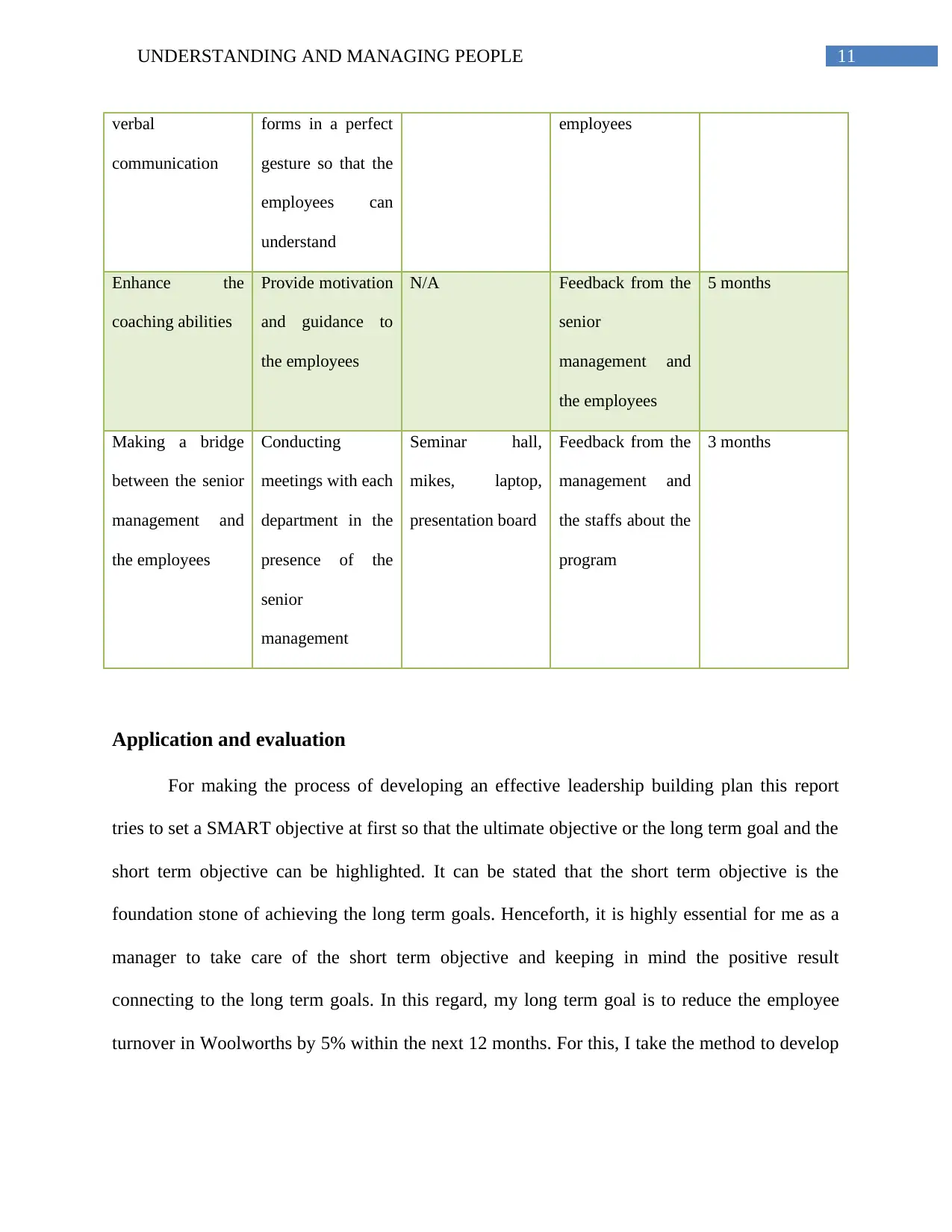
11UNDERSTANDING AND MANAGING PEOPLE
verbal
communication
forms in a perfect
gesture so that the
employees can
understand
employees
Enhance the
coaching abilities
Provide motivation
and guidance to
the employees
N/A Feedback from the
senior
management and
the employees
5 months
Making a bridge
between the senior
management and
the employees
Conducting
meetings with each
department in the
presence of the
senior
management
Seminar hall,
mikes, laptop,
presentation board
Feedback from the
management and
the staffs about the
program
3 months
Application and evaluation
For making the process of developing an effective leadership building plan this report
tries to set a SMART objective at first so that the ultimate objective or the long term goal and the
short term objective can be highlighted. It can be stated that the short term objective is the
foundation stone of achieving the long term goals. Henceforth, it is highly essential for me as a
manager to take care of the short term objective and keeping in mind the positive result
connecting to the long term goals. In this regard, my long term goal is to reduce the employee
turnover in Woolworths by 5% within the next 12 months. For this, I take the method to develop
verbal
communication
forms in a perfect
gesture so that the
employees can
understand
employees
Enhance the
coaching abilities
Provide motivation
and guidance to
the employees
N/A Feedback from the
senior
management and
the employees
5 months
Making a bridge
between the senior
management and
the employees
Conducting
meetings with each
department in the
presence of the
senior
management
Seminar hall,
mikes, laptop,
presentation board
Feedback from the
management and
the staffs about the
program
3 months
Application and evaluation
For making the process of developing an effective leadership building plan this report
tries to set a SMART objective at first so that the ultimate objective or the long term goal and the
short term objective can be highlighted. It can be stated that the short term objective is the
foundation stone of achieving the long term goals. Henceforth, it is highly essential for me as a
manager to take care of the short term objective and keeping in mind the positive result
connecting to the long term goals. In this regard, my long term goal is to reduce the employee
turnover in Woolworths by 5% within the next 12 months. For this, I take the method to develop
⊘ This is a preview!⊘
Do you want full access?
Subscribe today to unlock all pages.

Trusted by 1+ million students worldwide
1 out of 18
Related Documents
Your All-in-One AI-Powered Toolkit for Academic Success.
+13062052269
info@desklib.com
Available 24*7 on WhatsApp / Email
![[object Object]](/_next/static/media/star-bottom.7253800d.svg)
Unlock your academic potential
Copyright © 2020–2025 A2Z Services. All Rights Reserved. Developed and managed by ZUCOL.




